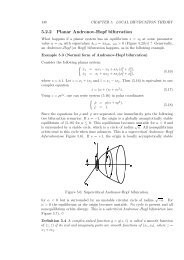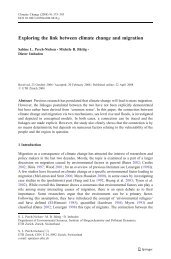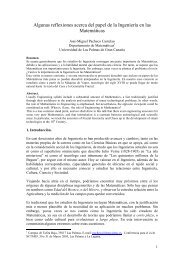Resilience in aquatic ecosystems - hysteresis, homeostasis, and ...
Resilience in aquatic ecosystems - hysteresis, homeostasis, and ...
Resilience in aquatic ecosystems - hysteresis, homeostasis, and ...
You also want an ePaper? Increase the reach of your titles
YUMPU automatically turns print PDFs into web optimized ePapers that Google loves.
16<br />
Reynolds/ Aquatic Ecosystem Health <strong>and</strong> Management 5 (2002) 3–17<br />
stress (Costanza <strong>and</strong> Mageau, 1999). Is this not just<br />
another way of ask<strong>in</strong>g how much structural <strong>and</strong><br />
resourc<strong>in</strong>g resilience the system has<br />
In the same way that systems emerge only through<br />
the aggregate of the behaviors of <strong>in</strong>dividual organisms<br />
of discrete populations, so system health should be<br />
manifest <strong>in</strong> the representation of key <strong>in</strong>dicator species<br />
<strong>and</strong> functional types. Thus, the <strong>in</strong>dices of ecosystem<br />
susta<strong>in</strong>ability promoted by Costanza <strong>and</strong> Mageau<br />
(1999) provide a ready framework of dimensions for<br />
dist<strong>in</strong>guish<strong>in</strong>g “good” from less desirable resilience.<br />
The l<strong>in</strong>es <strong>in</strong> Figure 5a represent the axes of a threedimensional<br />
plot, which share a common orig<strong>in</strong> at<br />
“0”. The z-dimension corresponds to specific process<strong>in</strong>g<br />
rate (represent<strong>in</strong>g gross primary production,<br />
forag<strong>in</strong>g rate, oxidative capacity); the y-dimension<br />
corresponds to structure (represent<strong>in</strong>g greater species<br />
richness <strong>and</strong> <strong>in</strong>terconnectance, more <strong>in</strong>formation<br />
organized <strong>in</strong> more biological complexity). These two<br />
axes def<strong>in</strong>e a (y-z) plane analogous to that used by<br />
Reynolds (1999) to dist<strong>in</strong>guish lakes on the basis of<br />
their metabolic properties. The third (x-) dimension<br />
corresponds to resilience as a separate measure of<br />
ecosystem behavior. It was not qualified by Costanza<br />
<strong>and</strong> Mageau; their <strong>in</strong>tention is the “structural” context<br />
but it holds for “resourc<strong>in</strong>g” too. In Figure 5b, two trajectories<br />
of ecosystem development are <strong>in</strong>serted <strong>in</strong>to<br />
the three-dimensional space created by the axis<br />
boundaries. For simplicity, they refer strictly to the<br />
early development <strong>and</strong> they do not show symptoms of<br />
disturbance. Both trajectories commence close to the<br />
orig<strong>in</strong> <strong>and</strong>, quite properly, demonstrate high biomass<br />
production. Both trajectories acquire resilience, also<br />
as anticipated but one of them also rises with respect<br />
to the y axis, as it ga<strong>in</strong>s more species, develops more<br />
network connectances <strong>and</strong> becomes more complex.<br />
This is the trajectory of Ulanowicz’ (1986) ascendancy<br />
<strong>and</strong> the resilience it builds is of the structural k<strong>in</strong>d.<br />
The other trajectory advances <strong>in</strong> productivity <strong>and</strong> process<strong>in</strong>g<br />
but the biomass <strong>in</strong>vestment is <strong>in</strong> a few specialist<br />
species, not <strong>in</strong> structural diversity. Managers<br />
will attest to its high resilience to therapy. The second<br />
trajectory acquires resourc<strong>in</strong>g resilience but high<br />
diversity is delayed. It is productive but has low <strong>in</strong>formation.<br />
Presently judgement resides with the view that<br />
high-diversity, low-productivity systems are healthier<br />
than low-diversity ones, though high productivity is a<br />
characteristic of early successions <strong>and</strong> it is what<br />
makes them so attractive for exploitation. For<br />
exploitation to be susta<strong>in</strong>able, systems must always be<br />
allowed the resilience to recover their ascendancy.<br />
References<br />
Azam, F., Fenchel, T., Field, J. G., Gray, J. S., Meyer-Reil, L. A.,<br />
Th<strong>in</strong>gstad, T., 1983. The ecological role of water-column<br />
microbes <strong>in</strong> the sea. Mar. Ecol. Prog. Ser. 10, 257––263.<br />
Bratbak, G., Th<strong>in</strong>gstad, T. F., 1985. Phytoplankton-bacteria <strong>in</strong>teractions:<br />
An apparent paradox Analysis of a model system with<br />
both competition <strong>and</strong> commensalism. Mar. Ecol. Prog. Ser. 25,<br />
23–30.<br />
Brown, J. H., Maurer, B. A., 1989. Macroecology: The division of<br />
food <strong>and</strong> space among species on cont<strong>in</strong>ents. Science 243,<br />
1145–1150.<br />
Carpenter, S. R., Kitchell, J. F., 1993. The Trophic Cascades <strong>in</strong><br />
Lakes. Cambridge University Press, New York, NY.<br />
Carpenter, S. R., Kitchell, J. F., Hodgson, J. R., 1985. Cascad<strong>in</strong>g<br />
trophic <strong>in</strong>teractions <strong>and</strong> lake productivity. Biosciences 35,<br />
634–639.<br />
Connell, J. H., 1978. Diversity <strong>in</strong> tropical ra<strong>in</strong> forests <strong>and</strong> coral<br />
reefs. Science 199, 1302–1310.<br />
Costanza, R., Mageau, M., 1999. What is a healthy ecosystem<br />
Aquat. Ecol. 33, 105–115.<br />
Dryden, R. C., Wright, S. J. L., 1987. Predation of cyanobacteria by<br />
protozoa. Can. J. Microbiol. 33, 471–482.<br />
Elliott, J. M., Hurley, M. A., 1999. A new energetics model for<br />
brown trout, Salmo trutta. Freshwat. Biol. 42, 235–246.<br />
Geider, R. J., Osborne, B. A., 1992. Algal Photosynthesis: The<br />
Measurement of Algal Gas Exchange. Chapman & Hall,<br />
New York.<br />
Gleick, J., 1988. Chaos. He<strong>in</strong>emann, London.<br />
Gliwicz, Z. M., Preis, A., 1977. Can planktivorous fish keep <strong>in</strong><br />
check planktonic crustacean populations A test of the sizeefficiency<br />
hypothesis. Ekol. Polska, Ser. A 25, 567–591.<br />
Greenwood, P. H., 1963. A History of Fishes (2nd ed.). Ernest Benn,<br />
London.<br />
Gull<strong>and</strong>, J. A. , 1983. Fish Stock Assessment. John Wiley & Sons,<br />
Chichester.<br />
Hairston, N. G., Smith, F. E., Slobodk<strong>in</strong>, L. B., 1960. Community<br />
structure, population control <strong>and</strong> competition. Am. Nat. 94,<br />
421–425.<br />
Harrison, G. W., 1979. Stability under environmental stress:<br />
Resistance, resilience, persistence <strong>and</strong> variability. Am. Nat. 115,<br />
659–669.<br />
Holl<strong>in</strong>g, C. S., 1973. <strong>Resilience</strong> <strong>and</strong> stability of ecological systems.<br />
Annu. Rev. Ecol. System. 4, 1–23.<br />
Huisman, J., Oostven, P., Weiss<strong>in</strong>g, F. J., 1999. Critical depth <strong>and</strong><br />
critical turbulence: Two different mechanisms for the development<br />
of phytoplankton blooms. Limnol. Oceanog. 1781–1787.<br />
Jónasson, P. M., 1996. Limits for life <strong>in</strong> the lake ecosystem.<br />
Verh<strong>and</strong>lungen der <strong>in</strong>ternationale Vere<strong>in</strong>igung für theoretische<br />
und angew<strong>and</strong>te Limnologie 26, 1–33.<br />
Jones, R. I., 1992. The <strong>in</strong>fluence of humic substances <strong>in</strong> lacustr<strong>in</strong>e<br />
planktonic food cha<strong>in</strong>s. Hydrobiologia 229, 73–91.<br />
Jørgensen, S.-E., 1982. Exergy <strong>and</strong> buffer<strong>in</strong>g capacity <strong>in</strong> ecological<br />
systems. In: W. Mitsch, R. Ragade, R. Bosserman, J. Dillon<br />
(Eds.), Energetics <strong>and</strong> Systems, pp. 61–72. Ann Arbor Science<br />
Publishers, Ann Arbor.<br />
Kirk, J. T. O., 1994. Light <strong>and</strong> Photosynthesis <strong>in</strong> Aquatic<br />
Ecosystems (2nd ed.). Cambridge University Press, Cambridge.






